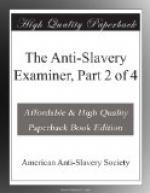I have frequently heard him speak against slavery to his visitors. I heard him say on one occasion, when some gentlemen were arguing in favor of sending the free colored people to Africa, that this was as really the black man’s country as the white’s, and that it would be as humane to knock the free negroes, at once, on the head, as to send them to Liberia. He was a kind man to his slaves. He was proud of them, and of the reputation he enjoyed of feeding and clothing them well. They were as near as I can judge about 300 in number. He never to my knowledge sold a slave, unless to go with a wife or husband, and at the slave’s own request. But all except the very wealthiest planters in his neighborhood sold them frequently. John Smoot of Powhatan Co. has sold a great number. Bacon Tait[A] used to be one of the principal purchasers. He had a jail at Richmond where he kept them. There were many others who made a business of buying and selling slaves. I saw on one occasion while travelling with my master, a gang of nearly two hundred men fastened with chains. The women followed unchained and the children in wagons. It was a sorrowful sight. Some were praying, some crying, and they all had a look of extreme wretchedness. It is an awful thing to a Virginia slave to be sold for the Alabama and Mississippi country. I have known some of them to die of grief, and others to commit suicide, on account of it.
[Footnote A: Bacon Tait’s advertisement of “new and commodious buildings” for the keeping of negroes, situated at the corner of 15th and Carey streets, appears in the Richmond Whig of Sept. 1896.—EDITOR.]
In my seventeenth year, I was married to a girl named Harriet, belonging to John Gatewood, a planter living about four miles from Mr. Pleasant. She was about a year younger than myself—was a tailoress, and used to cut out clothes for the hands.
We were married by a white clergyman named Jones; and were allowed to or three weeks to ourselves, which we spent in visiting and other amusements.
The field hands are seldom married by a clergyman. They simply invite their friends together, and have a wedding party.
Our two eldest children died in their infancy: two are now living. The youngest was only two months old when I saw him for the last time. I used to visit my wife on Saturday and Sunday evenings.
My young master came back from Europe in delicate health. He was advised by his physicians to spend the winter in New-Orleans, whither he accordingly went, taking me with him. Here he became acquainted with a French lady of one of the first families in the city. The next winter he also spent in New-Orleans, and on his third visit, three years after his return from Europe, he was married to the lady above mentioned. In May he returned to Mt. Pleasant, and found the elder Larrimore on his sick bed, from which he never rose again. He died on the 14th of July. There was a great and splendid funeral, as his relatives and friends were numerous.




